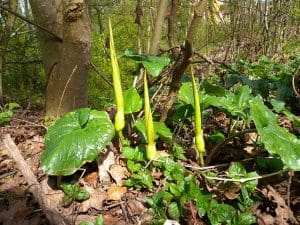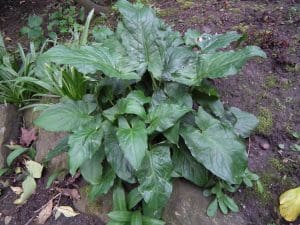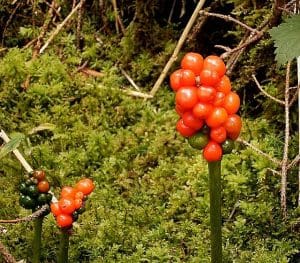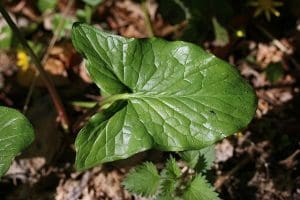Lords and Ladies / Spring / Summer / Autumn / Toxic
Through this piece, we’re going to look at the full Identification Guide for Lords and Ladies as well as how to make sure we don’t confuse this one with common or lambs sorrel or accidentally pick it amongst our wild garlic gathering.
A very common, toxic species. Anyone who gathers wild garlic should be aware of this plant as it appears at the same time of year in similar locations.
Common Names
Lords and Ladies,
Devils and Angels,
Adam and Eve,
Cuckoo-pint,
Snakes Head
Botanical Name
Arum maculatum
Scientific Classification
Kingdom – Plantae
Order – Alismatales
Family – Araceae
Lords and Ladies Identification Video
Physical Characteristics for Lords and Ladies
Stems
The flowers grow on a poker-shaped spike called a spadix, this is partially covered in a green leaf-like hood called a spathe.
The spathe can be up to 25 cm high and the fruiting spike which follows later in the season may be up to 5 cm.

Leaves
The leaves appear in the spring and are 7 to 20 cm long.
They are dark green, glossy/waxy, and can have purple or dark blotches on them. (I’ve also seen some garden grown varieties with white lines and blotches on them)
The leaves are harpoon shaped with two distinctive points on the base of the leaves sticking out on either side of the stalk.

Flowers
The tiny, yellow flowers are hidden at the base of the spadix.
There is a ring of male flowers at the top and female flowers below.
Fruits & Berries
The berries appear after the flower dies back and are bright red, they can still persist until winter and really stand out. (I always think the berries look like a sweet sticky lollipop that should taste sweet and delightful – however, don’t be fooled by their allure – they’re still no good for eating)
Also sometimes known as the devils lollipop.

Roots
The large roots or tubers are used to store starch and can be up to a foot underground.
Habitat
The plant prefers damp, shady environments, woodlands, riverbanks and hedgerows.
Known Hazards
All parts of the plant are toxic and can produce severe allergic reactions so care needs to be taken.
The plant very often grows in the same places as Wild Garlic (Allium ursinum) and just touching the leaves can irritate your skin.
The berries are potentially deadly poisonous, they contain oxalates of saponins which have needle-shaped crystals that irritate the skin.
They can cause swelling of the throat and breathing difficulties if consumed and as there is no known antidote this can sometimes be fatal.
In reality they give you a tingling, burning sensation as soon as they touch your lips so it would be difficult to eat enough to do any real harm.
I have heard reports of people using the leaves as woodland toilet paper with painful consequences.
Could be Confused with…
It has been confused with Common Sorrel (Rumex acetosa) but Sorrel has pointed ‘tails’ at the end of its leaves whereas Lords and Ladies are rounded. Common Sorrel is found growing with open fields whereas Lords and ladies are typically found growing in damp woodlands.
The Italian arum (Arum italicum) is almost identical but this has green and white variegated leaves.
Edible Uses
Although toxic raw, the root can be used once thoroughly roasted, it was ground and was once traded under the name of Portland sago.
In the past it was used to make a drink called saloop, which was widely drunk before the introduction of tea and coffee.
The roasted and ground roots can also be used as a substitute for Arrowroot to thicken soups and stews.
Be aware if not correctly prepared it is highly toxic.
Notes on Herbal Uses
It was used in the past to induce sweating and vomiting, and to treat internal parasites.
Extra notes from the Foragers
The roots were a traditionally source of starch used for laundry particular in churches. Apparently, only starch made from plants could be used on communion linen.
The common name Lords and Ladies and many of the other common names liken the plant to male and female genitalia.
The hood created by this plant around the flowering tops has a warmer temperature than the surrounding space, growing in spring this warm space is welcomed by insects and they often spend time in there, whilst in there the plants drop pollen on to them to spread further afield.
References
3 replies on “Lords and Ladies (Arum maculatum) Identification”
Leave a Reply
You must be logged in to post a comment.








This is a plant that Kurds have eaten the leaves for thousands of year, and no one has ever died from it. however, there is a special way of cooking it that gets rid of the toxins in the leaves. I grew up eating this and I love the taste of it so much!! you can cook it as a soup or with rice. It is Called ” Kardi or ” Kardu” in Kurdish. Also, people in Iran mainly the Kurds that are in Iran forge it too.
I find this with a lot of things are classed as toxic in one country and commonly eaten in another with special preperation. Would you be happening to explain the preperation process that would be used for this one?